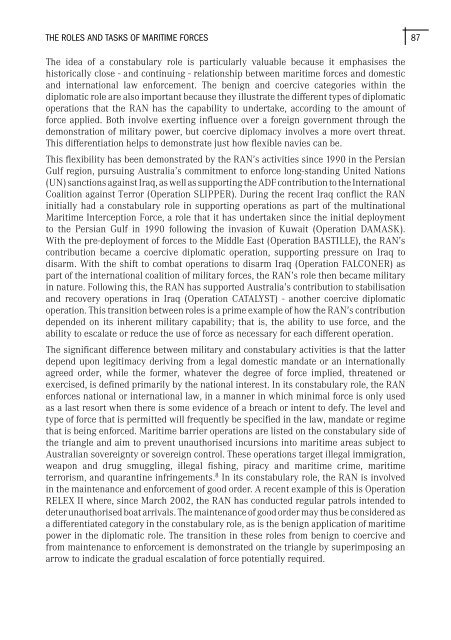Australian Maritime Issues 2005 - Royal Australian Navy
Australian Maritime Issues 2005 - Royal Australian Navy
Australian Maritime Issues 2005 - Royal Australian Navy
Create successful ePaper yourself
Turn your PDF publications into a flip-book with our unique Google optimized e-Paper software.
THE ROLES AND TASKS OF MARITIME FORCES<br />
87<br />
The idea of a constabulary role is particularly valuable because it emphasises the<br />
historically close - and continuing - relationship between maritime forces and domestic<br />
and international law enforcement. The benign and coercive categories within the<br />
diplomatic role are also important because they illustrate the different types of diplomatic<br />
operations that the RAN has the capability to undertake, according to the amount of<br />
force applied. Both involve exerting influence over a foreign government through the<br />
demonstration of military power, but coercive diplomacy involves a more overt threat.<br />
This differentiation helps to demonstrate just how flexible navies can be.<br />
This flexibility has been demonstrated by the RAN’s activities since 1990 in the Persian<br />
Gulf region, pursuing Australia’s commitment to enforce long-standing United Nations<br />
(UN) sanctions against Iraq, as well as supporting the ADF contribution to the International<br />
Coalition against Terror (Operation SLIPPER). During the recent Iraq conflict the RAN<br />
initially had a constabulary role in supporting operations as part of the multinational<br />
<strong>Maritime</strong> Interception Force, a role that it has undertaken since the initial deployment<br />
to the Persian Gulf in 1990 following the invasion of Kuwait (Operation DAMASK).<br />
With the pre-deployment of forces to the Middle East (Operation BASTILLE), the RAN’s<br />
contribution became a coercive diplomatic operation, supporting pressure on Iraq to<br />
disarm. With the shift to combat operations to disarm Iraq (Operation FALCONER) as<br />
part of the international coalition of military forces, the RAN’s role then became military<br />
in nature. Following this, the RAN has supported Australia’s contribution to stabilisation<br />
and recovery operations in Iraq (Operation CATALYST) - another coercive diplomatic<br />
operation. This transition between roles is a prime example of how the RAN’s contribution<br />
depended on its inherent military capability; that is, the ability to use force, and the<br />
ability to escalate or reduce the use of force as necessary for each different operation.<br />
The significant difference between military and constabulary activities is that the latter<br />
depend upon legitimacy deriving from a legal domestic mandate or an internationally<br />
agreed order, while the former, whatever the degree of force implied, threatened or<br />
exercised, is defined primarily by the national interest. In its constabulary role, the RAN<br />
enforces national or international law, in a manner in which minimal force is only used<br />
as a last resort when there is some evidence of a breach or intent to defy. The level and<br />
type of force that is permitted will frequently be specified in the law, mandate or regime<br />
that is being enforced. <strong>Maritime</strong> barrier operations are listed on the constabulary side of<br />
the triangle and aim to prevent unauthorised incursions into maritime areas subject to<br />
<strong>Australian</strong> sovereignty or sovereign control. These operations target illegal immigration,<br />
weapon and drug smuggling, illegal fishing, piracy and maritime crime, maritime<br />
terrorism, and quarantine infringements. 8 In its constabulary role, the RAN is involved<br />
in the maintenance and enforcement of good order. A recent example of this is Operation<br />
RELEX II where, since March 2002, the RAN has conducted regular patrols intended to<br />
deter unauthorised boat arrivals. The maintenance of good order may thus be considered as<br />
a differentiated category in the constabulary role, as is the benign application of maritime<br />
power in the diplomatic role. The transition in these roles from benign to coercive and<br />
from maintenance to enforcement is demonstrated on the triangle by superimposing an<br />
arrow to indicate the gradual escalation of force potentially required.

















